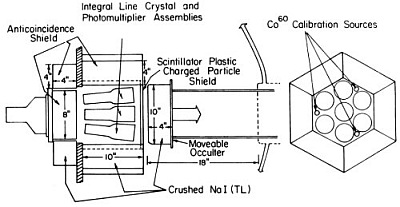Purpose of the flight and payload description
The large area gamma ray telescope can be seen in the scheme at left. It consisted of an array of seven 7.6 cm x 7.6 cm Nal(Tl) integral line scintillation detectors with a photopeak sensitivity of 135 cm2 at 0.662 MeV and 20 cm2 at 6.13 MeV. Coarse collimation properties was gived by 10.2 cm thick active Nal(Tl) shielding at the sides of and behind the detector. The shielding consisted primarily of small (20-150 cm3) chunks of Nal(Tl) immersed in silicone oil in aluminum containers. A solid Nal(Tl) crystal scintillator shielded the rear of the detector, and the front aperture was covered by a 1.3 cm thick NE-102 plastic scintillator giving charged-particle shielding. Three small plastic scintillators doped with CO60 were mounted on their own photomultiplier tube and provided tagged energy calibration data during flight. The instrument counts with a movable shutter/occulter that can be used to occult sources, but which was not used for this flight.
Details of the balloon flight
Balloon launched on: 11/21/1977 at 20:08 utc
Launch site: Australian Balloon Launching Station, Alice Springs, Australia
Balloon launched by: National Scientific Balloon Facility (NSBF)
Balloon manufacturer/size/composition: Zero Pressure Balloon Winzen 433.248 m3 (12.70 microns Stratofilm)
Flight identification number: 145N
End of flight (L for landing time, W for last contact, otherwise termination time): 11/23/1977 at 7:37 utc
Balloon flight duration (F: time at float only, otherwise total flight time in d:days / h:hours or m:minutes - ): F 47 h 45 m
Payload weight: 1090 kgs
External references
- Limit on galactic 6.13 MeV gamma-ray line Astrophysical Journal, Part 1, vol. 244, Mar. 15, 1981, p. 1081-1086
- National Scientific Balloon Facility Annual Report FY 1978 National Center for Atmospheric Research, January 1979
- Upper limits to pulsed gamma ray emission from PSR 0833-45, 1747-46, and 1818-04 International Cosmic Ray Conference, 17th, Paris, France, July 13-25, 1981, Conference Papers. Volume 9.
4729If you consider this website interesting or useful, you can help me to keep it up and running with a small donation to cover the operational costs. Just the equivalent of the price of a cup of coffee helps a lot.


